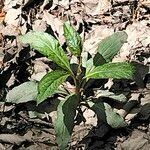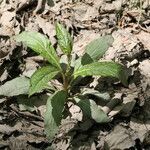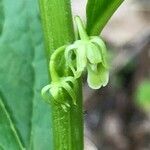Plants subshrubs, perennial, 30–80(–100) cm, from thick rhizome with fibrous roots. Stems 1 or several-clustered, erect, simple, usually hairy, sometimes glabrous or subglabrous. Leaves: proximal and distal alternate, petiolate, distalmost sessile or nearly so; stipules narrowly elliptic to linear or lanceolate, (0.5–)4–25(–30) mm, sparsely hirsute; petiole 6–20 mm; blade elliptic or oblanceolate, 6.5–17 × 1.5–6 cm, base attenuate or acuminate, margins entire or sparsely serrate, ciliate or eciliate, apex acute to long-acuminate, surfaces usually strigose and/or sericeous, sometimes glabrous, trichomes scattered throughout or concentrated along outer margins, veins, or petiole. Inflorescences 1–3-flowered; peduncle recurved at anthesis, becoming erect, 5–23 mm, pilose; bracteoles present. Flowers: sepals often spreading from corolla, linear to linear-lanceolate, margins ciliate or eciliate, apex acute; petals: upper and laterals greenish white, oblong, 3.5–5 mm, margins usually with scattered cilia, apex usually truncate and recurved, glabrous; lowest greenish white, 4–5.5 mm, claw 0–1 × 3–4 mm, usually longer and wider than others, distal limb oblong, ± flat to convex, 3–5 mm wide, apex retuse, sometimes rounded, usually glabrous; cleistogamous flowers, when present, from axils of distal leaves. Capsules oblong to ellipsoid, (8–)15–20 mm. Seeds 6–9, white to cream, globose to broadly ovoid, (3–)4–7 mm. 2n = 48.
More
Stems to 1 m, solitary or clustered, from a crown of fibrous roots; herbage ± hairy; lvs broadly elliptic to ovate-oblong, 7–16 cm, abruptly acuminate, tapering to slender petioles 1–2 cm; fls greenish-white, 4–5 mm, solitary or several in the axils on strongly recurved peduncles jointed beyond the middle; sep linear, nearly as long as the pet; fr oblong-ellipsoid, 1.5–2 cm; seeds subglobose, 5 mm; 2n=48. Rich woods and ravines; Vt. and Ont. to Mich. and Kans., s. to N.C., Ga., and Ark. May, June. (Cubelium c.)



